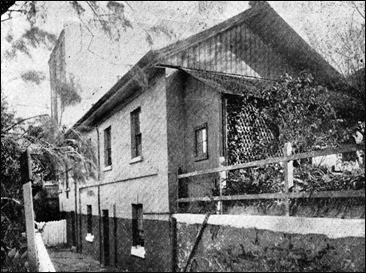I would like you to take a peep at a little bit of almost unknown Old Sydney. Men have passed by it for years without being aware of its existence. If you look over the fence on the southern side of the Sailors’ Home, or, better still, go round to the road at the back of the home, you will find an old house tucked under the shade of the main building. The house is quite below the present level of George street, and looks as if it had dug itself in to let change and progress go by without disturbing its calm.
Built in 1816 or 1817 (it was in use in April 1817), the old house during its hundred years of life has seen a wonderful panorama pass both in the street behind and on the waters before it. When it was young, Macquarie walked in the land and probably had been within its doors.

A BIT OF ALMOST UNKNOWN OLD SYDNEY.
This 100-year-old house stands alongside the Sailors’ Home in George street North. Built for the coxswain and crew of the Government boats about 1817, it afterward became the home of the Water Police. Now it is part of the Sailors’ Home.
On George street it has watched while one man has given place to hundreds, and on the sea it has seen the cockleshell grow to the mammoth liner. The house was built as a residence for the Government coxswain and boat’s crew of a hundred years ago. Mr. John Cadman, on a princely salary of £30 a year, upheld the dignity of the coxswain. He was for twenty-five years, Mr. Norman Selfe records, “the principal superintendent of Government boats, and so identified himself with the naval yard that it was often spoken of as ‘Cadman’s.’ . . .
Cadman died on the 12th November 1848, only two months short of 91 years old, and gave up his position when Governor Gipps left the colony in August 1846, ‘not at his age wishing to serve any other Governor,’ as his epitaph says.” In or about the year 1847, the house became the home of the Water Police, and it remained in their possession until 1865, when Captain Robinson, superintendent of the Sailors’ Home, took it over.

In front of both, the house and the site of the Sailors’ Home were two little bays with sandy beaches. In between was a causeway with steps at the end, which stood close to the present back-gate of the house. High water reached to within eight feet of its walls, and a worthy friend of mine, who is not an old man, used to fish as a boy in front of the building. On the north side of the Sailors’ Home, a part of the original rocky shore of the Quay may still be seen.
My friend remembers, also, the time when he and a son of Captain Robinson purloined a big ship’s rocket, set it up against the fence seen in the illustration, and fired it. The roar of that rocket as it flashed through a ship’s rigging, across the Quay, and landed in the quarry on the other side, is still in his ears. I referred in the first chapter to two little bays shown on Hunter’s sketch. These would be the bays in front of this house, and the landing from the First Fleet, if it took place on the western side, was made a few yards south of the site of this building.
